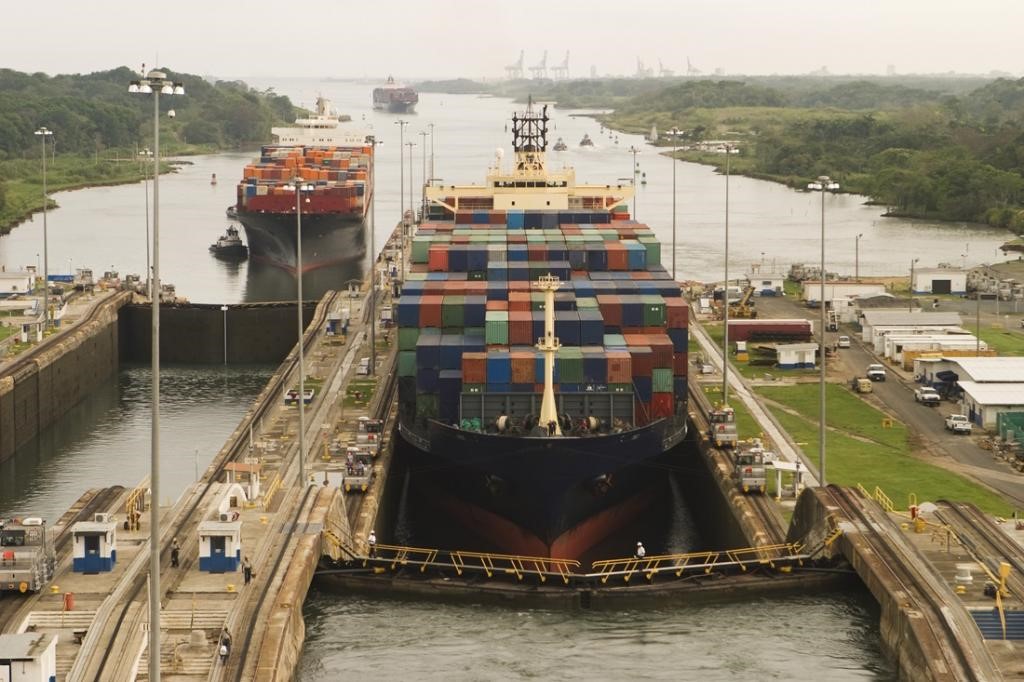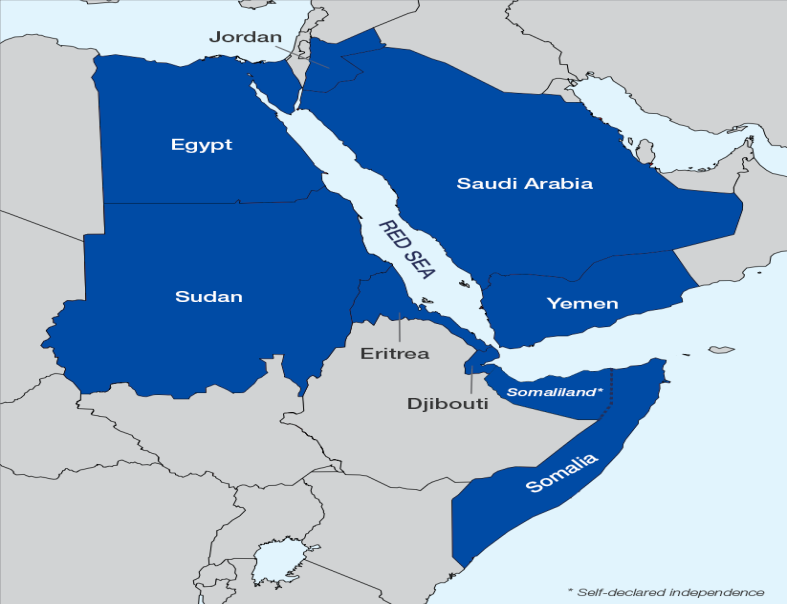Description

Disclaimer: Copyright infringement not intended.
Context
The United Nations Conference on Trade and Development (UNCTAD) expressed concern on January 26, 2024, over increasing disruptions in global trade caused due to the impact of climate change and war on shipping in three key sea lanes: The Black Sea, the Red Sea and the Panama Canal.
Details
Black Sea
Geographical Location
- The Black Sea, also known as the Euxine Sea, is one of the major water bodies and a famous inland sea of the world.
- The area surrounding the Black Sea is commonly referred to as the Black Sea Region.
- This marginal sea of the Atlantic Ocean, located between Eastern Europe and Western Asia.
- It is surrounded by the Pontic, Caucasus, and Crimean Mountains in the south, east and north respectively.
- The Turkish straits system - the Dardanelles, Bosporus and Marmara Sea - forms a transitional zone between the Mediterranean and the Black Sea.
- The Black Sea is also connected to the Sea of Azov by the Strait of Kerch.
- The bordering countries of Black Sea are: Russia, Ukraine, Georgia, Turkey, Bulgaria and Romania.
- The Black Sea drains into the Mediterranean Sea, via the Aegean Sea and various straits.
Straits
- Kerch Strait: The Black Sea and the Sea of Azov are connected by the Kerch Strait.
- It is between the Crimean peninsula of Kerch and the Russian peninsula of Taman.
- It gets its name from the city of Kerch (a city on the Kerch Peninsula in the east of Crimea).
- Bosphorus strait: The Black Sea and the Sea of Marmara are joined by the Bosphorus Strait.
- Dardanelles strait: The Aegean Sea and the Sea of Marmara are joined by the Dardanelles Strait.
Limited Oxygen Levels
- The Black Sea's deeper waters have lower levels of oxygen due to its unique geological and hydrological conditions.
- The lack of oxygen in the lower layers creates a distinct environment, and it is one of the world's largest anoxic basins, meaning it has areas with very little dissolved oxygen.
- Islands: It contains several islands, with the largest ones being Snake Island (Ukraine), Giresun Island (Turkey) and St. Ivan Island (Bulgaria).
Trade through the Black Sea
- At the crossroads of Europe and Asia, the Black Sea is an important artery for commodity flow.
- The Black Sea is used to transport crude oil, refined oil, agricultural goods, and iron and steel.
- The Bloomberg report says that Ukraine and Russia trade more than a quarter of the world’s wheat, almost a fifth of its corn, and most of its sunflower oil.
Red sea:
- Red Sea is a narrow strip of water extending south-eastward from Suez, Egypt, for about 1,930 km to the Bab-el-Mandeb Strait, which connects with the Gulf of Aden and thence with the Arabian Sea.
- It is a semi-enclosed inlet (or extension) of the Indian Ocean between the continents of Africa and Asia. It is one of the world’s warmest seas.
- The northern portion of the Red Sea is bifurcated by the Sinai Peninsula into the Gulf of Aqaba and the Gulf of Suez, where it is connected to the Mediterranean Sea via the famous Suez Canal.
- Geology: The Red Sea was formed by the Arabian peninsula being split from the Horn of Africa by movement of the Red Sea Rift.
- Salinity: The Red Sea is one of the saltiest bodies of water in the world, owing to high evaporation and low precipitation; no significant rivers or streams drain into the sea, and its southern connection to the Gulf of Aden, an arm of the Indian Ocean, is narrow.
- Ecosystem: The rich diversity is in part due to the 2,000 km (1,240 mi) of coral reef extending along its coastline. The Red Sea also contains many offshore reefs including several true atolls.

Bordering Countries:
- Yemen and Saudi Arabia border the Red Sea to the east.
- It is bordered by Egypt to the north and west and by Sudan, Eritrea, and Djibouti to the west.
- This sea has a surface area of roughly 438,000 km2 and is about 2,250 km in length.
- The maximum width of the sea is 355 km, and the sea’s deepest point is 3,040 m at the central Suakin Trough, with the sea’s estimated average depth being 490 m.
- Islands: Some well-known islands include Tiran Island, which is located near the mouth of the Gulf of Aqaba, and Shadwan Island, which is located at the entrance of the Gulf of Suez.
Panama Canal
- Panama Canal is located in Central America.
- It is a lock-type canal, owned and administered by the Republic of Panama.
- Lock-type canal is a system in which an enclosure or basin located in the course of a canal or a river (or in the vicinity of a dock) with gates at each end, within which the water level may be varied to raise or lower boats.
- Panama Canal connects the Atlantic Ocean and the Pacific Ocean.
- The Panama Canal linking the Atlantic and Pacific Oceans is a water passage across the isthmus of Panama where it proved a vital component of expanding global trade routes in the 20th century.
- The Panama Canal was opened in 1914 after the startup of its creation by France in 1881and later on handed over to the US in 1904.
- The canal consists of artificial lakes, several improved and artificial channels, and three sets of locks as well as an additional artificial lake, Alajuela Lake (known during the American era as Madden Lake) which acts as a reservoir for the canal.
- It decreases the distance to go all around South America and anyone can go directly through this canal.

Recent Development
- The disruption in global trade first began on February 24, 2022, when Russian troops invaded Ukraine on the express orders of President Vladimir Putin.
- Russia also launched a blockade of Ukrainian Black Sea ports such as Odessa and Mykolayiv through which much of the global supply of wheat, sunflower oil and maize was exported through ‘choke points’ like the Straits of the Bosphorus and Dardanelles to the Mediterranean and globally.
- Russia and Ukraine signed a landmark deal — The Black Sea Grain Initiative brokered by the United Nations and Turkiye — in Istanbul on July 22, 2022, to allow the resumption of Ukrainian grain exports from ports on the Black Sea. In July 2023, Russia refused to renew the initiative after it expired.
- The ongoing conflict in Ukraine has triggered substantial shifts in oil and grain trades, reshaping established trade patterns. Simultaneously, the Panama Canal, a pivotal conduit for global trade, is grappling with diminished water levels, resulting in a staggering 36 per cent reduction in total transits over the past month compared to a year ago. The long-term implications of climate change on the canal’s capacity are raising concerns about enduring impacts on global supply chains.
- Global trade has also been affected in the Red Sea, which connects the Mediterranean (through the Suez Canal at its northern end) with the Indian Ocean (through the Strait of Bab El Mandeb in the south).
- The crisis in the Red Sea, marked by Houthi-led attacks disrupting shipping routes, has added another layer of complexity. Major players in the shipping industry have temporarily suspended Suez transits in response.
|
PRACTICE QUESTION
Consider the following pairs:
| Sea |
Bordering Country |
| Adriatic Sea |
Albania |
| Black Sea |
Croatia |
| Caspian Sea |
Kazakhstan |
| Mediterranean Sea |
Morocco |
| Red Sea |
Syria |
Which of the pairs given above are correctly matched?
(a) 1, 2 and 4 only
(b) 1, 3 and 4 only
(c) 2 and 5 only
(d) 1, 2, 3, 4 and 5
Ans: (b)
|












